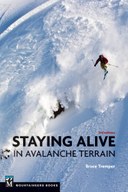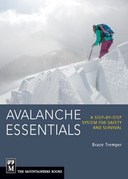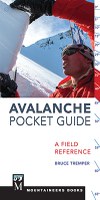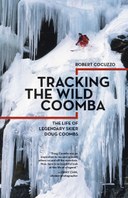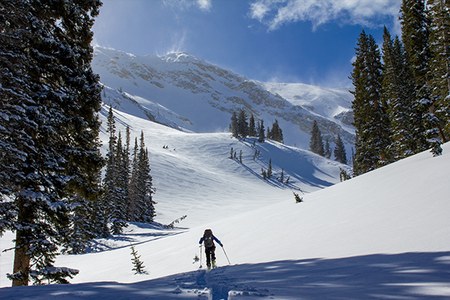
Bruce Tremper is the author of Staying Alive In Avalanche Terrain, which has just been published in the third edition. Staying Alive is the country's best-selling book on how to stay safe in avalanche country.
NOTE - DON'T MISS BRUCE'S WEB SEMINAR,
JANUARY 23, 6:00 PM PST (FREE). SAVE YOUR SEAT TODAY!
Recently retired, Bruce spent nearly 30 years at the Utah Avalanche Center, most of those years as its Director. Following is an excerpt from the introduction to the new edition of Staying Alive, in which Bruce explains how as a young hot-shot ski racer he learned that he wasn't as smart as he thought he was.
CAUGHT
bY bRUCE tREMPER
It was November 1978. I was a cocky, ex-national-circuit ski racer, twenty-four years old, fresh out of college, and because I needed the money, I was building chairlifts at Bridger Bowl Ski Area in Montana. In the ignorance and vigor of youth, I naturally enough considered myself to be an avalanche expert. I had grown up in the mountains of western Montana, where my father had taught me about avalanches when I was ten years old, and I had been skiing in the backcountry the past several years and had so far avoided any serious mishaps. In other words, I was a typical avalanche victim.
I was skiing alone (first mistake) and not wearing a transceiver (second mistake). After all, I wasn’t “skiing,” I was “working,” tightening the bolts at the base of each chairlift tower with a torque wrench. Even in my stubborn ignorance, I could see that it was clearly very dangerous. Over a foot of dense snow had fallen the night before, on top of fragile depth hoar, and the wind was blowing hard, loading up the steep slopes beneath the upper section of the chairlift with thick slabs of wind-drifted snow.
Starting from the top, I skied down, stopping at each tower to torque the bolts. When I was finished with the tower at the top of the avalanche paths, I took off my skis and started walking back up the slope so I could gain the ridge and circle around to the tower beneath the avalanche paths. Then I quickly discovered my third mistake. Since I did not bring my backcountry skis or climbing skins, the easy climb was now an exhausting pig wallow back up through chest-deep snow, and the nearby snow-free cliffs were too scary to climb in my slippery plastic boots. I couldn’t help but notice that only a thirty-foot-wide couloir at the base of the cliffs separated me from the safe slopes on the other side. Naturally enough, I thought a good skier like me should be able to get up speed and zip across it before anything too bad happened. Ski cutting alone and without a transceiver or partner—fourth mistake.
I did my ski cut according to the book. I built up speed and crossed the slope at about a 45-degree angle, so that, in theory, my momentum would carry me off the moving slab, in case it did break on me. Since I had never been caught in an avalanche before, I had no idea how quickly the slab—after it shatters like a pane of glass—can pick up speed. I heard a deep, muffled thunk as it fractured. Then it was like someone had pulled the rug out from under me, and I instantly flopped down onto the snow, losing all the precious speed I had built up. Like a startled cow, I sat there on my butt and watched the soft slab shatter into little blocks, and then the blanket of snow rocketed down the slope as if sucked downward by extra-heavy gravity.
I jumped to my feet and tried to build up my speed again so I could jet off to the side, but it was far too late. The blocks of shattered slab were moving all around me, like a herd of tumbling cardboard boxes blown by the wind. Nothing seemed to work. Even though only two or three seconds had elapsed, the avalanche, with me as its unintended passenger, was already moving a good 30 kilometers per hour (kmh; about 20 miles per hour, mph). Looking downhill, I saw a line of small trees coming toward me at a frightening speed. They looked like periscopes slicing through the water in an old World War II movie. I tried to maneuver to grab one of them. But avalanches, as I discovered, pretty much have their way with you. Choice is a luxury you think you might have before you are caught in an avalanche, but never afterward. Luckily, the avalanche took me directly into the smallest tree, and I slammed into it hard and held on with all my strength. The snow pounded me like I was standing under a huge waterfall, and it felt like my neck would snap as each block of wind-blown slab smashed into my head. Luckily, most of the snow had passed by me before the tree trunk snapped off, which probably saved my life, but I was rocketing down the slope again.
Then the tumbling started, over and over like being stuck in a giant washing machine filled with snow. Hat and mittens, instantly gone. Snow went everywhere: down my neck, up my sleeves, down my underwear—even under my eyelids, something I would have never imagined. With every breath, I sucked in a mixture of snow and air that instantly formed a plug in my mouth and down into my throat. I coughed it out, but the next breath rammed my throat full of snow again. Just when I needed to breathe the most, I couldn’t—I was drowning, high in the mountains, in the middle of winter, and miles from the nearest body of water.
After a long while, when I was about to pass out from lack of air, the avalanche began to slow down, and the tumbling finally stopped. I was on the surface, and I could breathe again. But as I bobbed along on the soft, moving blanket of snow, which had slowed from about 100 kmh (roughly 60 mph) to around 65 kmh (40 mph), I discovered that my body would sink if I didn’t swim hard.
So I swam. But something was pulling one of my legs down. These were the days before ski brakes, and I had safety straps attaching my skis to my boots. I could swim, but my skis couldn’t. One safety strap had torn the heelpiece out of my ski, but the other one remained attached, and it felt like a boat anchor tied to my leg. The ski was beneath me in the slower moving debris, and as the surface debris moved faster, it tipped me forward, shoving my face into the snow again and again. I struggled hard to pull that ski up through the debris while still furiously swimming. Eventually, the swimming worked, and when the avalanche finally came to a stop, I found myself upright and buried only chest deep, breathing hard, very wet, very cold, and very lucky.
I remembered from avalanche books that debris sets up like concrete the instant it comes to a stop, but it’s one of those facts you don’t entirely believe. Sure enough, I was in a body cast from the chest down. Barehanded, I chipped away at the rock-hard snow for a good ten minutes with my shovel before I could finally work my legs free. On one foot, the heel piece of the binding hung from the safety strap with a six-inch section of the top skin of the ski still attached to the screws. It had pulled completely off the ski. On my other foot, the ski was still intact, but both the tip and the tail were broken. How I could have broken both skis, yet none of my bones, has always been a mystery to me.
I decided that day that, no, I wasn’t an avalanche expert—not even close—and that was the real beginning of my avalanche education. Within a month I had luckily landed a job on the ski patrol doing avalanche control, where the old pros quickly took me under their wings. I have always been grateful to those guys, especially my childhood friend and ski-racing buddy, Doug Richmond, who patiently tutored me through those first couple of years. He could see that I was an accident waiting to happen, as full of myself as I was and living with the delusion that I knew much more about avalanches than I did. His friendship, instruction, and love have saved my life many times since then and helped set me on a new career path. I promised myself I would do the same for others, which I have, and this book is part of that promise.
I don’t think it’s possible to watch a huge natural event, especially a cataclysmic one, without having the experience change your life. Volcano watchers, tornado chasers, eclipse junkies—they all saw their first one, and then nothing was the same anymore: the unspeakable power, the beauty, the horror, the insignificance of humanity in the face of it all. They spend the rest of their lives trying to find it again. In an avalanche, the mountainside shatters like a pane of glass and roars down at 60 mph (100 kmh), ripping out trees. I rode one and somehow survived, and I have been haunted by them and have hunted them ever since. Avalanches will probably never let me go.
* * * * *
(Photo at top by Bruce Tremper.)
 Mountaineers Books
Mountaineers Books
